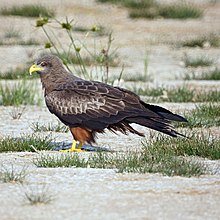Yellow-billed kite
| Yellow-billed kite | |
|---|---|

| |
| Adult in Limpopo, South Africa | |

| |
| Immature in the Kruger Park, South Africa | |
| Scientific classification | |
| Kingdom: | |
| Phylum: | |
| Class: | |
| Order: | |
| Family: | |
| Genus: | |
| Species: | M. aegyptius
|
| Binomial name | |
| Milvus aegyptius Gmelin, 1788
| |
| Subspecies | |
| |
The yellow-billed kite (Milvus aegyptius) is the Afrotropic counterpart of the black kite (Milvus migrans), of which it is most often considered a subspecies. However, recent DNA studies suggest that the yellow-billed kite differs significantly from black kites in the Eurasian clade, and should be considered as a separate, allopatric species.[1]
There are two subspecies: M. a. parasitus, found throughout most of sub-Saharan Africa (including Madagascar), except for the Congo Basin (with intra-African migrations) and M. a. aegyptius of Egypt, south-west Arabia and the Horn of Africa (which disperses south during the non-breeding season).
Description
As suggested by its name, the yellow-billed kite is easily recognized by its entirely yellow bill, unlike that of the black kite (which is present in Africa as a visitor during the North Hemisphere winter). However, immature yellow-billed kites resemble the black kites of the corresponding age.
Status
It is mostly an intra-African breeding migrant, present in Southern Africa July–March and sometimes as late as May. It is generally common.
Habitat and feeding
They are found in almost all habitats, including parks in suburbia, but rare in the arid Namib and Karoo. They feed on a wide range of small vertebrates and insects, much of which is scavenged.
-
Milvus aegyptius parasitus
-
In flight
References
External links
- Yellow-billed kite - Species text in The Atlas of Southern African Birds



